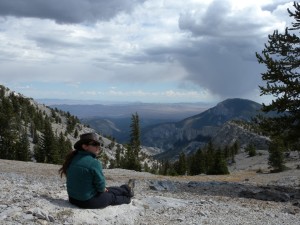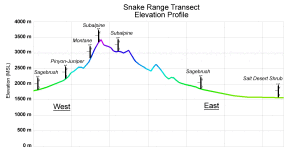
When studying mountain systems, limiting your focus to a single elevation can also limit the story you can elicit from your observations. Intuitively it may seem that a bristlecone pine stand, a pika community, or a montane snowpack is disconnected from processes occurring at other (especially lower) elevations. In fact, the hydrological and particularly the atmospheric dynamics in mountain systems connect all elevations together. Large-scale disturbances such as wildfire can move swiftly from the lowest to the highest elevations. Major vegetation changes in one community can have impacts elsewhere as thermal or hydrological regimes are shifted. Miss out on what is happening elsewhere on the mountain, and you miss out on the real story.
It is common for researchers involved in environmental science to be niche-focused: dedicated to a single species, location, or phenomenon. Very often, agency management plans mirror this approach. This is important of course, but when the study area includes mountainous terrain, data gathering or monitoring of conditions really needs to be expanded to include as much of the elevation gradient as possible. A more “holistic” approach to understanding near-surface dynamics is required in complex topography because, well, it’s complex! As more and more information comes in from studies incorporating gradients, more and more of the accepted knowledge of how systems behave is being questioned. Understanding eco-hydrological controls, their relationships to specific weather and atmospheric circulation patterns, and implications for long-term climatic drivers of change in niche phenomena is the next challenge in mountain science. Indeed, environmental science in general.
Point measurements of a variable in mountainous terrain are not particularly useful if there is only one point: extrapolation only becomes possible with concurrent observations in diverse settings. Snow scientists have known this for a long time, but there is some lag in many ecological circles (although not all!). Some of this gets back to the need for field time.
“Understanding eco-hydrological controls, their relationships to specific weather and atmospheric circulation patterns, and implications for long-term climatic drivers of change in niche phenomena is the next challenge in mountain, indeed environmental, science.”

Rather than focusing intensive monitoring of a specific portion of the mountains, a more useful approach is to attack the whole gradient. A valley-to-mountain transect of observation stations is particularly valuable if care is exercised in siting. Uniform and comparable measurements made simultaneously across complex terrain can instantly add interpretive value and lead to advanced lines of questioning.
In the following video, direct sublimation processes at montane elevations are visible as upwelling clouds along with lifting condensation from general area evaporative processes. Air temperature, relative humidity data, and imagery from a transect of weather stations in the mountain range tells us that unusually warmer air in the valley was drawn upslope, enhancing a sublimation effect on the sunlit southern slopes, while the shaded air conditions at the same elevations was not conducive to snowmelt and evaporation. In the end, we can visualize how snow on southern exposures may not necessarily contribute as much to soil and groundwater recharge as more protected snow in these conditions.
What other questions about eco-hydrologcial processes does this video raise? How could gathering data across the elevation gradient help?
